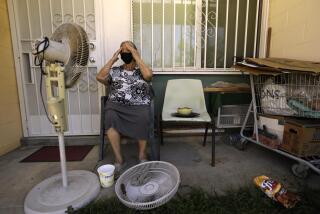Home Improvement : Blocking Sun’s Heat With Barrier in Attic
- Share via
QUESTION: Even with my high air-conditioning electric bills, my house is uncomfortably warm in the afternoon. The heat seems to be coming straight down from the ceiling. What can I do myself to block this heat?
ANSWER: It is not your imagination that heat is blasting you from your ceiling. Your roof, in the hot afternoon sun, can easily reach 150 degrees or more. Even with adequate attic floor insulation, the hot roof radiates heat straight down through it to your ceiling. This not only increases your cooling costs, but it makes you feel warm long into the evening.
There are two easy and inexpensive do-it-yourself radiant barrier methods to block the roof’s heat from getting through to your ceiling. Both methods--special low-emissivity silver paint or reflective reinforced foil--are applied underneath the roof inside the attic. With foil installed, less than 5% of the radiant heat gets through.
The new type of special reflective low-emissivity paint is sprayed on the underside of your roof inside your attic. It reduces the emissivity (ability of a material to transfer radiant heat) from about 85% for normal roof sheathing, to less than 20%.
With the special paint applied, the heat from the hot roof is not able to be transmitted down to the insulation and the ceiling below. Instead, the excess heat is exhausted naturally through attic vents and from the roof shingles themselves. The roof itself does not get significantly hotter with the paint underneath and its life or durability is not affected.
You can spray the paint under your roof with an ordinary paint sprayer. It is also very effective to spray the paint on top of your roof, but it looks silvery. This reflects the sun’s heat before it reaches your roof and also protects your shingles from deterioration. Always wear approved safety and breathing gear when painting in an enclosed area.
Another simple method is to install radiant barrier aluminum foil under the roof rafters. With a very low emissivity, 95% of the radiant heat from your roof is blocked from your ceiling. The foil is usually reinforced with plastic fiber or kraft paper for durability and simple installation.
It is very easy to install radiant barrier film yourself. The reinforced foil is available in long four-foot wide rolls. You just staple it to the underside of the roof rafters. The neatness of the job is not critical to the foil’s effectiveness at blocking the heat.
To be most effective, make sure you have adequate attic ventilation. Then the hot air between the foil and the roof will naturally flow up and out.
You can write to me for Utility Bills Update No. 130 listing addresses and telephone numbers of manufacturers of special low-emissivity paint and radiant barrier foils, a sample piece of foil, installation instructions and specifications, and a chart showing recommended required attic vent areas. Please include $1.50 and a self-addressed business-size envelope.
Is Particleboard Environmentally Safe?
Q: I have used particleboard in a well-insulated, tight room addition. What is particleboard made of and is it environmentally safe?
A: Particleboard is a relatively environmentally-friendly product. It is often made from over 90% waste wood from sawmills and logging operations. Much of the waste during production can be recycled in process.
The only possible problem is the outgassing of formaldehyde if you are particularly sensitive to it. Make sure to have adequate ventilation, especially during the first year and during hot humid conditions.
More to Read
Sign up for Essential California
The most important California stories and recommendations in your inbox every morning.
You may occasionally receive promotional content from the Los Angeles Times.






